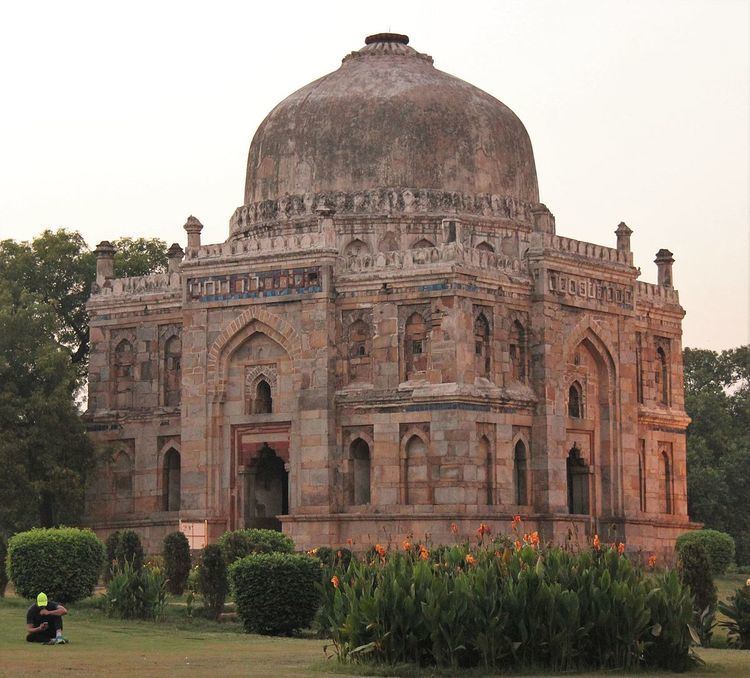Type Tomb Built 1489-1517 CE Phone 011 2464 7005 Designated as world heritage site 9 April 1936 | Location Lodhi Gardens Reference no. N-DL-76 Owner Government of Delhi | |
 | ||
Governing body Archaeological Survey of India
& NDMC Address Lodhi Road, Prathviraj Road Area, Lodhi Garden, New Delhi, Delhi 110003 Hours Open today · 6AM–7:30PMSunday6AM–7:30PMMonday6AM–7:30PMTuesday6AM–7:30PMWednesday(Rama Navami)6AM–7:30PMHours might differThursday6AM–7:30PMFriday6AM–7:30PMSaturday6AM–7:30PMSuggest an edit Architectural styles Islamic architecture, Hindu temple architecture Similar Bara Gumbad, Lodi Gardens, Tomb of Sikandar Lodi, Athpula Bridge, Tomb of Safdarjung | ||
Unknown tomb with blue tiles decoration known as shisha gumbad in lodi garden new delhi
Shisha Gumbad (Hindi: शीशा गुम्बद) (literal English translation of "Shisha" is "glass" and "Gumbad" is "Dome") is a tomb from the last lineage of the Lodhi Dynasty and is thought to have possibly been constructed between 1489 and 1517 CE. The Shisha Gumbad (glass dome) houses tombs of an unknown family that may have been a part of the Lodhi family and a part of Sikandar Lodi's court. It is however believed by some historians that the tomb is of Bahlul Lodi (died 12 July 1489), who was chief of the Pashtun Lodi tribe and founder & Sultan of the Lodi dynasty of the Delhi Sultanate, though Ibrahim Lodhi's Tomb exists 100 kilometres (62 mi) away at Panipat city in Haryana state.
Contents
- Unknown tomb with blue tiles decoration known as shisha gumbad in lodi garden new delhi
- History
- Construction
- Location
- References
Shisha Gumbad is situated in the Lodhi Gardens in Delhi and the area where the tomb is situated was formally called village Khairpur.
History
Exact date of construction of Shisha Gumbad is not known. There are four monuments (tombs) in the Lodhi Gardens including the Shisha Gumbad. The oldest of the four tombs is the tomb of Muhammad Shah (who belonged to the Sayyid dynasty). Shah's tomb was constructed in 1444 CE by Ala-ud-din Alam Shah. During the rule of Sikander Lodhi, the Bara Gumbad and adjacent mosque were constructed. Sikander Lodhi's tomb was built by Ibrahim Lodhi in 1517. The Shisha Gumbad is said to have been constructed between 1489-1517 CE by Ibrahim Lodhi.
Although some historians believe that the Gumbad is a tomb of Bahlul Lodi, who was the Sultan of the Lodi dynasty of the Delhi Sultanate, the Shisha Gumbad houses tombs of an unknown family that may have been a part of the Lodhi family and a part of Sikandar Lodi's court.
Initially, all the monuments were built independently and were not in one confine. In early 20th century, a park was developed which was inaugurated by Lady Willingdon on 9 Apr 1936 bringing the four monuments in one confine.
Construction
Constructed between 1489-1517 CE, the Shisha Gumbad is constructed in square shape. Combination of bracket and lintel beams, the architecture is a blend of Islamic and Hindu architectures. Although the Gumbad has an external semblance of spanning in two floors, the structure made only in one floor. The western wall of the Gumbad consists of mihrab which also served as a mosque. The main chamber of the monument measures 10 square metres (108 sq ft).
The ceiling is decorated with plaster work that contains Quranic inscriptions and floral designs. The monument was originally decorated with blue enamelled tiles that shined like glass. The Gumbad hence got its name "Shisha Gumbad". The blue tile embellishment presently only remains on top of the main frontage in traces.
Location
The Shisha Gumbad is located in and is a part of the Lodhi Gardens in Delhi, India. The village, where the monument stands was earlier called Khairpur. The garden is bounded by Amrita Shergill Marg in the West, North-West and North, Max MuellerMarg on the East and Lodhi Road on the South Side. Safdarjang Tomb is situated on South-West corner of the Lodhi Garden.
